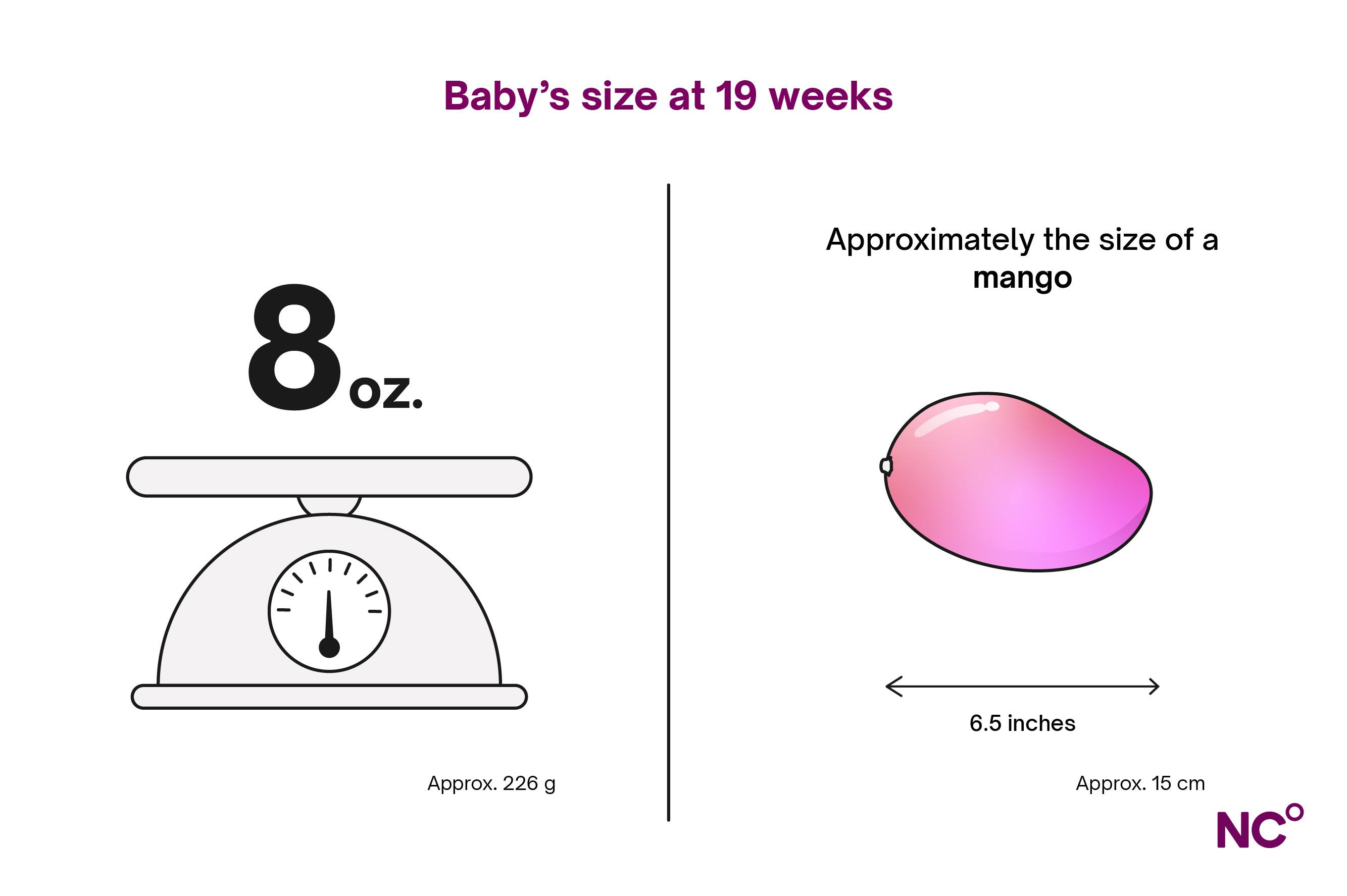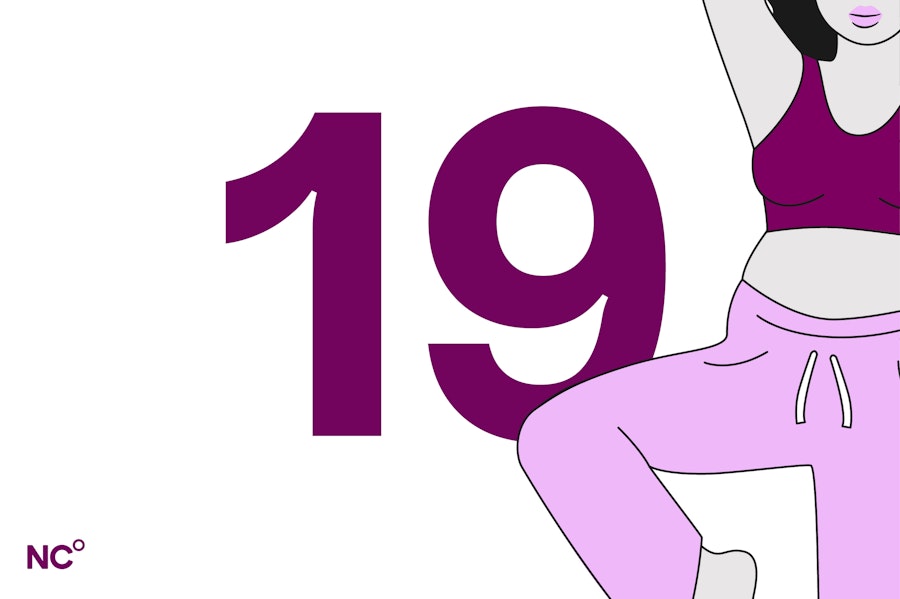19 Weeks pregnant: Symptoms, baby development and tips
Follows NC° Editorial Policy
At Natural Cycles, our mission is to empower you with the knowledge you need to take charge of your health. At Cycle Matters, we create fact-checked, expert-written content that tackles these topics in a compassionate and accessible way. Read more...
Key takeaways:
- Pregnancy is linked to a number of common skin conditions like melasma and acne, as well as uncommon conditions that might require medical attention — learning what to look out for can help you stay prepared
- Your baby is beginning to cover itself in vernix caseosa, that white creamy substance that can be seen on most newborns at birth
- Leg cramps and shortness of breath are some new pregnancy symptoms that can start around week 19
Welcome to week 19 of your pregnancy! In this week’s guide, we’ll dive deep into your skin and cover both the common and more uncommon skin conditions that can arise during pregnancy. We’ll also check in on your baby and touch on some pregnancy symptoms you might be experiencing this week. Finally, we’ll offer some tips on things you can do this week to take some time to care for yourself.
Your body at week 19
Common skin changes
There are a number of changes to your skin that are common during pregnancy, particularly starting in the second trimester, including melasma, linea nigra, and acne.
Melasma, also known as chloasma, is the darkening of skin patches due to an increase in melanin, the body’s natural pigmentation substance. You might also notice that areas of your skin that are already darker, like freckles, moles, nipples, areolas (the skin around your nipples), and labia, can become even darker. Melasma is not harmful, but doctors advise wearing sunscreen, using a hat while outside, and staying out of the sun to prevent melasma from getting worse. While some spots and patches can fade postpartum, it’s also possible that they remain after pregnancy [1].
Linea nigra refers to the dark line that might develop vertically across your pregnant belly. Despite what you might have heard, the length and size of linea nigra has not been proven to be linked to your baby’s sex. For most of us, this line will fade postpartum, but a faint line might remain for years after pregnancy.
Pregnancy is unfortunately also linked to flare-ups of acne, and for some, can worsen existing acne. The American College of Obstetricians and Gynecologists (ACOG) advise that over-the-counter (OTC) acne treatments that contain topical benzoyl peroxide, azelaic acid, topical salicylic acid, and glycolic acid are all safe to use if you are suffering from breakouts [1]. Unfortunately, many common acne prescription medications, as well as some OTC treatments for acne, are not advised for use during pregnancy. Speak with your healthcare provider if you have any questions regarding ingredients or the use of acne treatments during pregnancy.
Finally, certain skin diseases like dermatitis and psoriasis may worsen (or improve) during pregnancy. Every woman and every pregnancy is different. If you are suffering from a skin condition, or an existing condition is worsening during your pregnancy, be sure to review any medications you would commonly take with your care team.
Uncommon skin changes
Some women can develop other skin-related health conditions during pregnancy. Though uncommon, familiarizing yourself with their symptoms can help you alert your physician if you suspect you’ve developed any of the following:
Pruritic urticarial papules and plaques of pregnancy (PUPPP), also known as polymorphic eruption of pregnancy (PEP), is the most common of the rare gestational dermatoses [2]. Small, red bumps and hives usually appear first on the stomach and can develop into large itchy patches that can spread to the thighs, butt and breasts. The condition is not known to cause any harm to mother or baby, though it is very uncomfortable. A physician will likely prescribe anti-itch medication, and PUPPP usually clears up about 3-6 weeks postpartum [2]. PUPPP occurs mostly in first-time pregnancies, is more common in multiple pregnancies (carrying twins or triplets), and tends not to recur in future pregnancies.
Prurigo is another itchy skin condition that resembles small insect bites. They can appear anywhere on the skin, and can develop at any point during pregnancy. Doctors believe that changes in your immune system during pregnancy are the culprit. Prurigo is usually treated with anti-itch medication, and usually resolves postpartum, although it can last for some time after your baby is born [1]. Prurigo is not known to pose any harm to mother or baby, though it can be very uncomfortable [3].
Pemphigoid gestationis (PG) is a rare autoimmune disease that usually starts in the second or third trimester, or right after birth. The main symptom is skin blisters that appear on the stomach. Because the condition slightly increases your risk of pregnancy complications like preterm birth, your doctor will likely monitor your pregnancy more closely if you are diagnosed with PG. You also might be prescribed medication to control your skin condition and relieve discomfort [1]. If you develop PG, there is around a 50-70% chance it will return in subsequent pregnancies [3].
Intrahepatic cholestasis of pregnancy (ICP) is a serious liver condition whose main symptom is itching on the soles of the feet and palms of the hands that commonly worse at night, occurring with no rash [4]. Studies have shown that ICP is more prevalent amongst certain patient populations, like those with South Asia origins [5]. Family history and maternal age also increase the risk of developing ICP during pregnancy. The ICP requires medical attention, as there is significant risk posed to mom and baby if left untreated [3].
Your baby’s development at 19 weeks
At week 19, your baby is already preparing for life outside of the uterus. While they continue to practice their kicks and punches, they are also starting to be covered by vernix caseosa. This white, creamy substance is actually made from your baby’s old skin cells. Its job is to help moisturize and hydrate your baby’s skin, to help them regulate their temperature, and to protect against microbes [6]. Vernix will still likely be on your baby when they are born.
Your growing baby is now weighing 7 to 8.5 ounces (200 to 240 grams) and measuring 6 to 7 inches in length (15.3 to 17.8 centimeters) [7]. Now that they are around the size of a mango, it’s likely you will be able to feel their movements more strongly. But remember, there’s no need to start counting their movements just yet.

Pregnancy symptoms in week 19
Leg cramps
Cramping in your calf muscles, and even your feet, is common in week 19. These painful spasms are more likely to occur at night, which can be quite a shock to wake up to! While there is no specific cause, or cure, they are linked to changes in your circulation and fatigue in your leg muscles.
While leg cramps aren’t preventable, staying active, drinking enough water, and maintaining a healthy diet can help [8]. You can also try stretching out your calves with your hands, a foam roller, or a muscle gun (if you and your doctor agree it is safe to use during your pregnancy) to help relieve tension.
Shortness of breath
As your baby grows throughout your second trimester, this can put pressure on your diaphragm and lungs causing shortness of breath. Your heart is also working overtime to pump extra blood throughout your body, which can make you feel out of breath. If you suffer from asthma or a lung infection like the flu, COVID-19, or pneumonia, pregnancy can worsen breathing issues. Iron deficiency, which is common in pregnancy, could also be the culprit [9].
Though mild shortness of breath is considered normal, if you find that your shortness of breath is sudden or severe, or if you experience chest pain, contact emergency services immediately. Similarly, if you experience shortness of breath alongside other symptoms like swelling in the hands, feet, or face, a headache, changes to your vision, or nausea, contact your healthcare provider as this might be a sign of preeclampsia [10]. Preeclampsia is a blood pressure-related disorder that develops most commonly in the second half of pregnancy and requires medical monitoring for the health of both mother and baby.
Tips in week 19
- Take some time for yourself: you might be hearing this constantly from family or friends, but your life is going to be changing in a major way after your baby is born. Try to take some time for yourself this week, whether that means taking a walk, reading a book, binging your favorite show, or spending some quality time with a friend or partner.
- Schedule your next ultrasound: you will likely have an ultrasound between weeks 18 and 22 to check on the baby’s development. If you haven’t scheduled this ultrasound, contact your care team. It will also be possible, if you want, to find out the sex of your baby at this ultrasound.
- Stretching out during the day: if you work at a computer all day, think about taking some extra time to stretch out during the day. Carpal tunnel, which can present as tingling, numbness or pain in your hand, is commonly experienced during pregnancy due to hormonal changes and fluid retention in the tissues of the wrist [11]. Taking regular breaks to walk around can also help relieve cramps and aches in your legs and hips.
- Consider adding extra magnesium to your diet: if you are experiencing leg cramps, recent studies have shown that adding extra magnesium to your diet might help [12]. Dark leafy vegetables, soy products, nuts like almonds and cashews, peanuts and peanut butter, whole grains breads and cereals, and bananas are also good sources of dietary magnesium.
Using Natural Cycles during your pregnancy
Did you know that Natural Cycles, the only FDA Cleared birth control app, can also support you throughout your pregnancy? With weekly guides, informative articles, and pregnancy symptom trackers, NC° Follow Pregnancy is designed to keep you up-to-date with interesting and useful information about the development of your baby and changes to your health. Feel supported throughout your pregnancy journey and beyond with Natural Cycles.
Did you enjoy reading this article?
